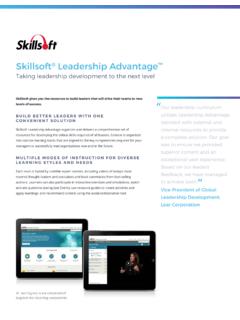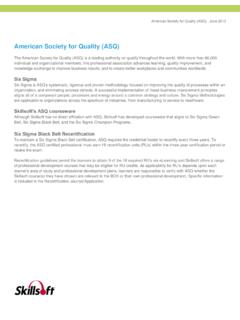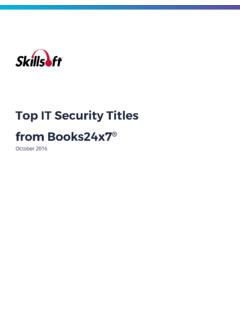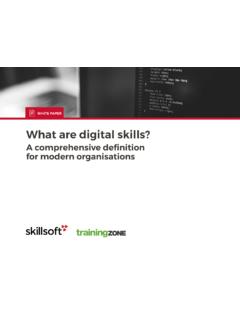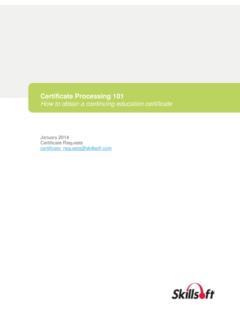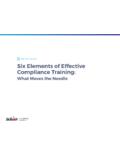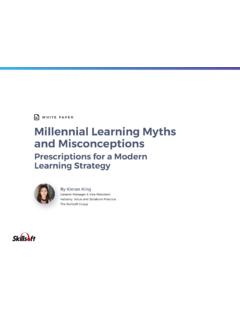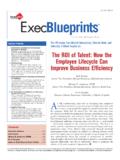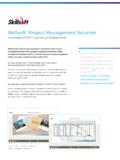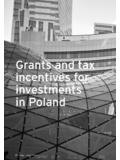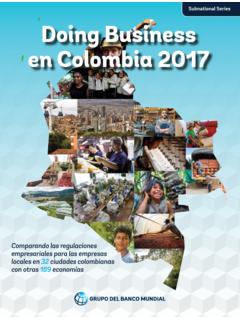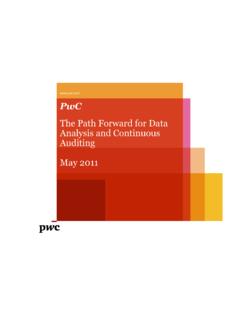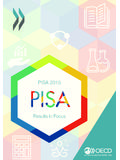Transcription of WHITE PAPER The Skillsoft Learning and Talent …
1 WHITE PAPERThe Skillsoft Learning and Talent maturity framework :A path to accelerate HR's adaptability and your workforce's agilityBy Kieran King Vice President, Global Customer Insight, SkillsoftKey Contributors: Brent Colescott, Director of Business Strategy and Transformation for SumTotal, A Skillsoft CompanyLaura Overton, Founder and CEO, Towards MaturityDr. Shreya Sarkar-Barney, President and Founder, Human Capital Growth PAPER | The Skillsoft Learning and Talent maturity framework : A path to HR adaptability and advantageous workforce agility2 SHARE ONTABLE OF CONTENTSW arnings have been issued, yet only a few are ready 4 What really good looks like .. the self-developing organization 6 The indicators of maturity 7 The nine success indicators 8 Thought-leader insight: Laura Overton, Managing Director, Towards maturity 12 Why Learning maturity matters 12 High aspirations of today s people professionals 12 What is holding organizations back?
2 13 Who is achieving the best results? 13 What are the top-performing Learning organizations doing differently? 14 maturity Matters 15 Learning and Talent Management maturity framework Matrix 16 Thought-leader insight: Shreya Sarkar-Barney, , President and Founder, Human Capital Growth 23 A roadmap to business impact 23 WHITE PAPER | The Skillsoft Learning and Talent maturity framework : A path to HR adaptability and advantageous workforce agility3 SHARE ONTABLE OF CONTENTS (CONTINUED) Why change? 23 Significance of the model 23 How to change? 24 Conclusion: take a step forward 25 About the author: Kieran King 26 About the key contributor: Brent Colescott 26 About the key contributor: Laura Overton 27 About the key contributor: Dr.
3 Shreya Sarkar-Barney 27 WHITE PAPER | The Skillsoft Learning and Talent maturity framework : A path to HR adaptability and advantageous workforce agility4 SHARE ONWARNINGS HAVE BEEN ISSUED, YET ONLY A FEW ARE READYIn 1997, a groundbreaking McKinsey study exposed workforce vulnerabilities for human resource teams in their book, "The War for Talent ," yet almost 20 years later as the human capital field is desperate for a revolution, most organizations are not prepared for battle. The dynamics of Talent s low supply and high demand are playing out across the globe, affecting every industry sector and continent. A recent study from PwC called "Redefining Business Success in a Changing World" found that 72% of CEOs are concerned about the availability of key skills and 48% are planning to increase headcount1.
4 However, the majority of human resource teams are still employing decades-old traditional practices which don t come close to addressing the priorities. In fact, a recent Deloitte University study2 reports that the percentage of companies rating Learning and development as a very high priority tripled in a year, yet organizational readiness is declining at a rapid rate. Only 40% of organizations indicated they were ready to face these challenges, which was 35 points less than the year before. This inverse dynamic is more than intellectually disturbing. Amid the readiness concerns for the overall workforce, retention and succession gaps are leading to anemic levels of qualified leaders. The same PwC CEO study reported that the top Talent concern among executives is fortifying the future leadership pipeline3.
5 Leadership capability is seen by CEOs as a key ingredient in an enterprise s ability to remain competitive and relevant. Given that high-performing leaders relate to a more engaged workforce, better productivity and nearly 50% higher profitability, leadership remains a top challenge for organizations4. In sum, the soft approach many HR teams have taken in the past won t cut it as organizations strive to meet hard business vulnerabilities. No doubt, it s difficult to change. The war for Talent will involve far more than novel recruiting tactics. It will take wholesale HR adaptation. To some enterprises, this might be quite disruptive. However, the need for organizations to morph how they manage and grow Talent is about as fundamental as Darwin s principles for evolutionary theory itself.
6 Conditions have changed remarkably. The demographic shifts, revamped business models, digitization of products, rise in big data analytics and new forms of competition require organizations to fuel perpetual skill upgrades. HR must evolve to apply new paradigms toward Talent attraction, mine for unrealized capability, build rapid development tactics, implement highly effective engagement strategies and unveil succession 1 19th Annual Global CEO Survey by PWC. 2016. 2 Global Human Capital Trends 2015, Leading in the New World of Work by Deloitte University Press. 2015. 3 19th Annual Global CEO Survey by PWC. State of the American Manager by Gallup. April 2015. According to Darwin s 'Origin of Species,' it is not the most intellectual of the species that survives; it is not the strongest that survives; but the species that survives is the one that is able best to adapt and adjust to the changing environment in which it finds C.
7 Megginson WHITE PAPER | The Skillsoft Learning and Talent maturity framework : A path to HR adaptability and advantageous workforce agility5 SHARE ONpathways with far more innovation than they have demonstrated to date. Old assumptions and stale practices need to be abandoned. Organizations who successfully compete for Talent will exploit technology to achieve a smarter way, build a healthier culture and develop a more resilient workforce. A key part of accomplishing better outcomes involves breaking down the artificial walls between Talent management and Learning . Talent management teams possess a wealth of insights into how the workforce needs to be shaped, while inordinate numbers of L&D departments are operating independent of this vital information.
8 As Figure 1 depicts, many organizations unintentionally silo the Talent management processes away from Learning . This bolted-on approach results in a clunky experience for employees and causes HR to apply focus toward fixing integration issues instead of building capabilities for the organization. When Talent and Learning are interwoven, the ability for employees and the organization to achieve its strategic results can be systemically actualized instead of coincidental. It is vital that HR analyze the business aims and align Talent and Learning to directly support each other. According to the Towards maturity benchmarking research, the best-in-class organizations routinely align their efforts with the business strategy.
9 In less mature organizations, only 36% of organizations repeatably look to align to the business agenda5. How can executives be expected to tolerate such lack of alignment?Organizations are recognizing that they must shift from training employees with an event-centric approach to designing environments where employee development flourishes as a growth enabler. Developing Talent is far more than setting up a catalog within an LMS and ensuring annual performance reviews take effect. As the interplay between the Talent management and Learning pieces gradually becomes more cohesive, and as the alignment to the strategic agenda improves, workforce performance levels increase. Learning becomes a lever that is truly embraced and encouraged as a synergistic part of the workflow and an intrinsic component of each Talent facet.
10 Achieving this type of symbiotic relationship between Talent and Learning not only dissolves silos, it also creates competitive differentiation. Organizations that apply this modern approach build superior employer brands, entice a higher level of Talent to join their ranks and optimize the existing workforce in new In-Focus Report: Aligning Learning to Business by Towards maturity . ManagementPerformance AppraisalWorkforce Planning360 Performance PlanningCareer ManagementSuccession PlanningTalent Sourcing & RecruitingIndividual Development PlansOrganizational Goal Setting, Tracking & CascadingCompensationFigure 1: Illustrative schematic of Talent and Learning process dysfunctionWhite PAPER | The Skillsoft Learning and Talent maturity framework : A path to HR adaptability and advantageous workforce agility6 SHARE ONWHAT REALLY GOOD LOOKS LIKE.
